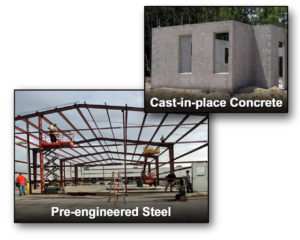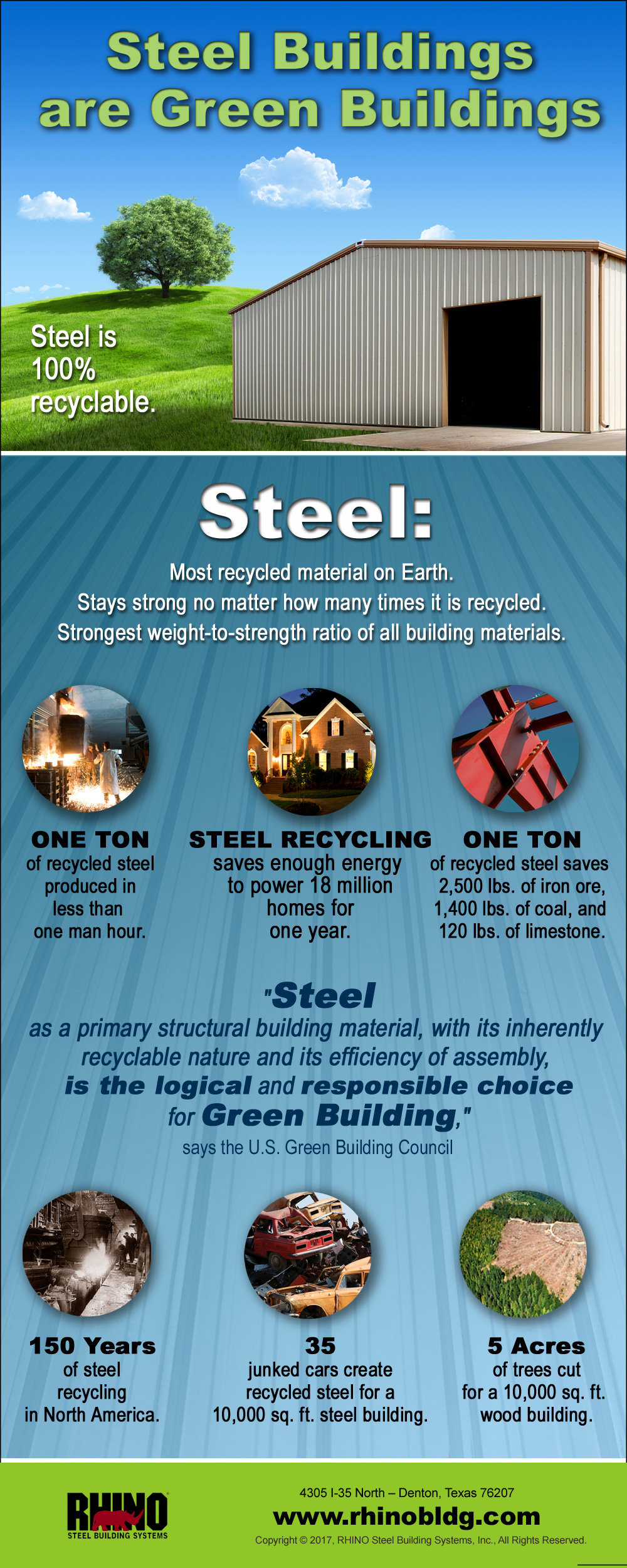Which Construction Method is Easiest on Your Pocketbook and the Planet?
 In an earlier blog, we discussed whether steel or concrete is the best building material for low-rise construction. We compared the pros and cons of each system in four categories: design, size, availability, and safety.
In an earlier blog, we discussed whether steel or concrete is the best building material for low-rise construction. We compared the pros and cons of each system in four categories: design, size, availability, and safety.
However, does a prefab steel building system or building with concrete cost less?
Is building with concrete or steel the best choice for our environment?
Steel vs. Concrete: Comparing Building System Material Costs
CONCRETE: Ordinarily, the price of concrete itself remains relatively stable. Moreover, concrete ingredients are inexpensive and readily available.
 STEEL: The secret to the affordability of a steel building system is steel’s strength.
STEEL: The secret to the affordability of a steel building system is steel’s strength.
Steel boasts the highest strength-to-weight ratio of any building material. Therefore, steel creates a stronger building with far less material than concrete. Less material equals less material costs.
In addition, innovations in steel production now allow for the creation of one ton of steel in less than one man-hour, making it an extremely cost-efficient building material.
Using recycled materials also reduces steel’s material price. Domestic structural steel contains 77% to 90% recycled steel.
In fact, the steel industry’s efficient steel scrap collection system recaptures 98% of all discarded steel products for recycling.
Steel vs. Concrete: Construction Method Costs
CONCRETE: Labor-intensive reinforced concrete buildings require a skilled contractor and experienced laborers for satisfactory results.
Building with concrete requires waiting for the concrete forms to cure thoroughly. That also lengthens construction time. The longer the construction time, the higher the construction costs.
STEEL: The prefabrication of the RHINO metal building system drastically cuts construction time, saving money on labor. The straightforward nature of the framing erection and steel construction requires fewer, less skilled workers, further cutting construction costs.
Faster construction reaps lower interim financing and builder’s risk insurance costs, too.
On small to mid-sized building projects, do-it-yourselfers often save money by erecting the framing themselves with a few friends. Yet, no do-it-yourselfer would dare take on reinforced concrete construction.
Steel vs. Concrete: Long Term Costs
When choosing a construction material, too many building owners fail to consider the cost of maintaining and operating the structure. Which building system offers the lowest long-term costs?
CONCRETE: The sheer mass of cast-in-place concrete reduces temperature swings and drafts, saving money on heating and cooling. However, concrete buildings do require constant maintenance and repair.
STEEL: Steel buildings hold their value for decade after decade with virtually no expensive maintenance.
Steel’s thermal transfer properties do present an energy-efficiency challenge. However, a first-class insulation system like RHINO’s Pro-Value Package easily overcomes that problem.
In fact, RHINO’s Pro-Value Insulation System reduces heating and cooling costs by about 50%!
Steel or Concrete: Environmental Impacts
Construction and demolition waste is a huge environmental problem.
The EPA estimates construction and demolition waste in the U.S. at 600 million tons per year. That is more than double the amount of municipal solid waste generated annually.
CONCRETE: At the end of its usefulness, the concrete in a building can be recycled— but it is no longer fit for construction use.
Recycling concrete is also NOT economical.
Consequently, only about 50% of demolition concrete is recycled. The other 50% ends up dumped into our overflowing landfills. That creates a real environmental problem.
Concrete is made with cement— a major source of carbon dioxide gas emissions.
On the other hand, light-colored concrete does reflect heat, which helps to reduce the effects of urban heat islands.
Fortunately, the steel rebar used in reinforced concrete buildings is 100% recyclable.
STEEL: As the most recycled material on the planet, steel reigns supreme as the greenest of all materials.
In fact, the U.S. Green Building Council proclaims steel framing as “the logical and responsible choice for Green Building.” Here’s why:
- Steel is the only material that retains all its strength no matter how many times it is recycled— and steel is 100% recyclable.
- The magnetic properties of steel scrap make it simple and economical to handle and recycle.
- Today Americans recycle nearly 100% of all structural steel.
- Recycling steel actually costs less than producing virgin steel.
- Every ton of steel recycled saves 2,500 pounds of iron ore, 1,400 pounds of coal, 120 pounds of limestone— and 10.9 million Btu’s of energy!
Why pay someone to haul away the concrete of your demolished building? Scrap dealers will actually pay you for the deconstructed steel framing!
Unfortunately, steel, like cement, also produces some carbon dioxide emissions. However, innovations in steel production in recent decades have reduced greenhouse emissions by 37%.
Ongoing research and development continues searching for ways to further reduce both emissions and energy used in steel production.
According to the American Iron and Steel Institute, “Today, the American steel industry operates with the lowest energy consumption per ton of steel produced in the world.”
Using reflective steel panels on metal buildings helps diminish urban heat island effects in cities.
Is RHINO’s Steel Building System or Building with Concrete Best for Your Project?
 Ultimately, only you can decide whether reinforced concrete or steel works best for your specific project.
Ultimately, only you can decide whether reinforced concrete or steel works best for your specific project.
Compare the design, the end use, and the building codes for your location, as well as the short-term and long-term costs.
One alternative you might consider is a hybrid building that employs both steel and concrete construction. For example, tilt-up concrete works very well in combination with RHINO’s pre-engineered steel framing.
Speak to a RHINO metal building specialist today for more information.
Find out more about hybrid structures using both prefab steel buildings and tilt-up concrete. Discuss your specific building requirements. Ask for a free, no obligation quote.
You can trust our experts and their years of steel building experience. Call RHINO today at 940.383.9566.
(Updated 6-30-2021. Originally published 4-6-2018.)
